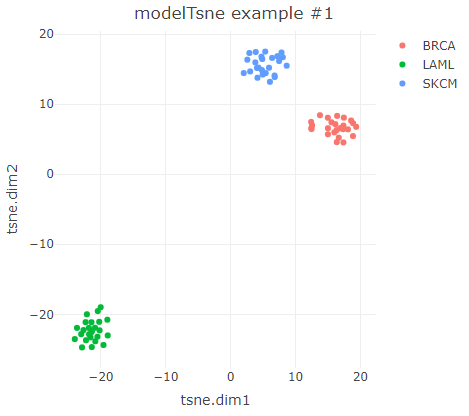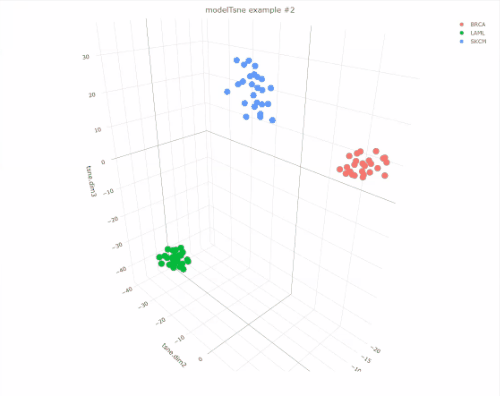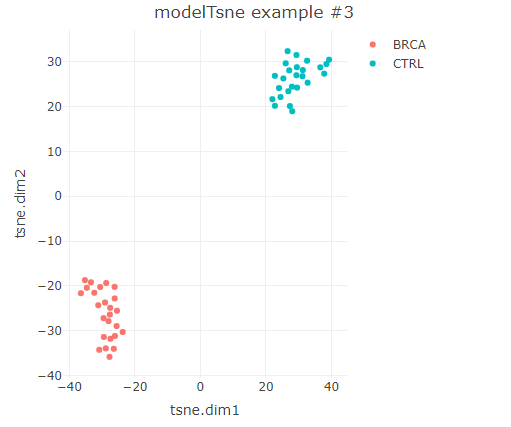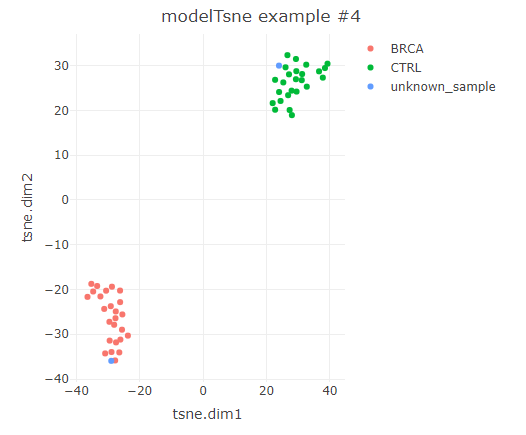The R package modelTsne provides functions to perform variable selection, t-SNE dimensional reduction analysis, generation and use of persistent t-SNE reference frameworks, and also, plot generation.
library(remotes)
install_github("oicr-gsi/modelTsne")- Build data frame, where columns correspond to samples and rows to variables.
- Variable selection: the function
variableSelection(data=..., method=...)returns the 'n' most informative variables in terms of high dispersion (IQR and SD) or discriminating power (ANOVA and logistic).
- Dimensional reduction with t-SNE:
modelTsne(data=..., perplexity=..., persistent=FALSE)performs t-SNE analysis and returns an 'ephemeral' model. - Plot t-SNE configuration using the function
plotTsne(model=..., method=...)to produce dynamic plots (method=plotly) or static plots (method=ggplot).
- Build a persistent t-SNE model: the function
modelTsne(data=..., perplexity=..., persistent=TRUE)performs t-SNE analysis and returns a persistentmodelTsneobject. - New sample analysis: the function
doTsneWithReference(data=...,model=...)is used to project data from new samples into the pre-existing t-SNE configuration of a persistentmodelTsneobject, and produces a new t-SNE configuration that contains both the original and the new samples. - Plot the resulting t-SNE configuration using the function
plotTsne(model=..., method=...)
We will use modelTsne to visualize DNA methylation data (M-values) from the TCGA project. The data frames meth_IQR1000, meth_ANOVA1000 and meth_unknown that are included in the package contain example data.
In the first example, the function selectVariables() is used to select the 500 most informative variables using the IQR method (prioritizes variables with high dispersion). Then, t-SNE analysis is performed by using modelTsne(), where the perplexity parameter is mandatory (typical values 5-50, results vary greatly from one dataset to another), and the optional parameter group will be part of the resulting modelTsne object and used during plotting but it does not influence t-SNE analysis. Finally, a plot of the resulting t-SNE configuration is generated with plotTsne().
library(modelTsne)
meth<-selectVariables(data=meth_IQR1000, method="IQR", no.variables=500)
group<-c(rep("BRCA",25),rep("LAML",25),rep("SKCM",25))
tsne<-modelTsne(data=meth, perplexity=12, group=group)
plotTsne(model=tsne, method="plotly", title="modelTsne example #1")
The number of dimensions of the t-SNE analysis can be specified by the dims parameter of modelTsne(). The function plotTsne() can handle 1-, 2- and 3-dimensional configurations (3 dimensions with plotTsne(...,method=plotly) only).
tsne<-modelTsne(data=meth, perplexity=12, group=group, dims=3)
plotTsne(model=tsne, method="plotly", title="modelTsne example #2")
To perform group-dependent variable selection, the selectVariables() function implements the ANOVA and logistic methods (prioritizes samples with lowest p-values). This approach is useful when SD and IQR approaches do no separate the groups of interest satisfactorily, which can be caused by the pressence in the dataset of a dominant trend that interferes or masks entirely the groups of interest.
group<-c(rep("BRCA",25),rep("CTRL",25))
meth<-selectVariables(data=meth_ANOVA1000, method="ANOVA", no.variables=500, group=group, threads=8)
tsne<-modelTsne(meth, perplexity=8, group=group)
plotTsne(tsne, method="plotly", title="modelTsne example #3")
A persistent t-SNE reference framework allows 'injecting' new data into a pre-existing dimensional reduction analysis. One application of this methodology is to provide a visual perspective of a classification problem without having to deal with 'shifting' reference configurations; modelTsne can be a powerful complement for a classifier but not a replacement.
tsne.persistent<-modelTsne(meth, perplexity=8, group=group, persistent=TRUE)
tsne<-doTsneWithReference(data=meth_unknown, model=tsne.persistent)
plotTsne(tsne, method="plotly", title="modelTsne example #4")
Developed by Alberto León at Ontario Institute for Cancer Research / Genome Sequence Informatics team







